No snow yet? No problem! At our CEFA Early Learning schools, we don’t wait for snow – we make our own! Treat your child to a snow day in the comfort of your own home with this simple, easy to make recipe. This is an excellent sensory learning activity which appeals to all children, young and old.
Make sure to save the snow once you are finished as it keeps a week or two, even longer sometimes.
This is an activity that is inexpensive to make and has no chemicals in it.
Best Ages for this Activity
Zero to five
How to Make It
You will need
- 2 cups Cornstarch
- 2 cups Baking soda
- Water
- A sensory bin. Use anything you might already have at home. I like the ones with lids because they are easy to store and put away when you need (under the bed is the perfect place). We use these bins for so many different sensory activities in the classrooms, and when my children were little, I always had one in their room that I changed every week or two. Now that they are 18 and 21 years old, that poor bin retired and found its way to one of our CEFA Early Learning schools. If you don’t have something to use around the house, you can purchase one here. We will use it for most of the sensory activities on this site. Otherwise, use a large tray, bowl or pan.
Let’s get Started
- Decide how much snow you want to make. As long as you keep a 1 to 1 ratio between the cornstarch and the baking soda, you can make as much or as little as you like.
- Invite your child to make “snow”
- Make sure that during this process, you encourage your child to do as much as they are capable of (for example, measuring, pouring, mixing, etc.) Help as little as you can so they learn the most from this activity.
- Explain that you will you the same amount (math concepts: equal, measuring, comparing) of cornstarch and baking soda, and decide how much snow you want to make.
- Measure 2 cups of each and pour into your sensory bin.
- Mix using your hands (sensory learning). Meanwhile, ask your child to describe how it feels on their fingers (vocabulary).
- Add water, a tiny bit at a time. You want to add a little and mix, until the consistency is such that you can form a snowball that does not disintegrate.
- Find any clumps and loosen them also using your fingers – this too is a good sensory exercise.
- Voilà! You have amazing snow to play with for the next week or two. Now why not build tiny snowpals (S.T.E.M.)? you could also recreate the scene of snowmen at night – this is ideal for it, and an excellent dramatic play and reading comprehension activity.
Learning Opportunities
Children will learn S.T.E.M. while making the snow. Questions you can ask your child during the experiment are:
- What happens when we add more water?
- What will you make with it once it is done?
By helping you measure, mix and describe textures, they will be learning math. As they are mixing and pouring, following all the steps, they are learning sequencing, which is great for reading as well as math and science.
Natacha’s tip: Remember to let your child do as much of the process as they are capable of. This means they measure, mix and pour (not you).
The process of making the snow offers your child sensory learning by using their senses to feel the texture. Sensory learning is especially important for writing. While you play with your child, use vocabulary to describe how it feels.
Don’t forget to use math vocabulary such as:
- Measuring
- Quantities (more than, less than, the same amount, 1 cup, etc.)
- Soft/softer/softest
- hard/harder/hardest
Describing while using vocabulary is one of the most important learning outcomes at this age. It teaches them reading and mathematics.
This activity improves your child’s ability to focus on one task (attention span) – especially once they get to do other activities with the snow – which contributes to your child’s social and emotional development and artistic development. They love knowing that they can “make” something to play with, it fosters a sense of independence and self-reliance.
Extended Learning Opportunities
Once it is ready and your child gets to play with it, they will gain writing skills by using their fine motor skills, and dramatic arts through pretend play. If you use the snow to build, you learn S.T.E.M., especially engineering.
Here are some examples of how to use your snow:
Use it with tools to work on fine motor skills and hand-eye coordination.
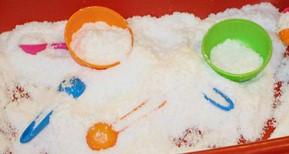
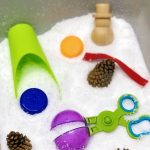
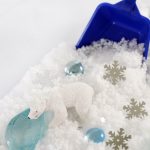
This snow is wonderful for dramatic play as it reminds your child of all the wonderful things that they can do in the winter and re-create a mini version of those activities right in their sensory bin. Presentation is everything, so set it up in a way that inspires your child to be creative with it and imagine all the things that can be added to it or built with it.
They can also imagine and recreate a construction site, a winter world with wildlife, and so many other things. Encourage them to look around the room and see what they can play with in their fresh new snow!
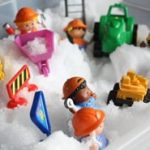
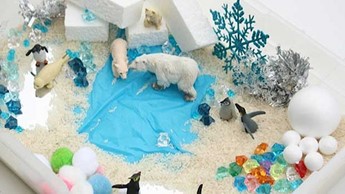
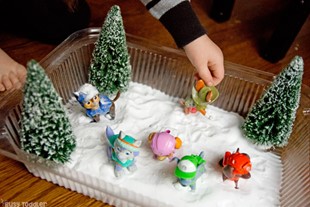
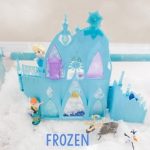
Read the book snowmen at night and re-create scenes of the book for dramatic play. This will teach your child reading comprehension and dramatic play. Here’s more snowmen at night activities you can do, plus a video link to the book read aloud if you don’t have it. If you build the scenes described in the book (for example, the skating rink, or the mountain where they go sledding), you add S.T.E.M. learning to this reading comprehension activity. You don’t have to use play dough to build everything! Use anything you find around the house, from big milk jugs to make hills to a mirror for the skating rink, or cups, wood and sticks. Use pine tree branches you find outside to make the trees if you like.
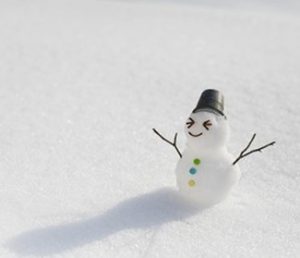
Invite your child to make your whole family out of snow. In addition to the fine motor skills required to make snowballs out of snow (which is harder than doing it with play dough) and then snowpals, it is a great social and emotional development activity and is often used by child therapists for role-play and for bringing issues to the surface. Ask questions like: if we were snowmen for a weekend, what would we do as a family? What would you do? What friends would you invite? Then why not build the places to go and what you will need? (for example, a snowy mountain to slide from and sleighs for the family). This is excellent for S.T.E.M. as well!
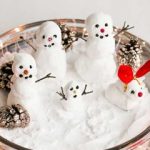
Another excellent S.T.E.M. activity is to use a very small pipette and add food colouring to your snow (you can use a little bit of the snow so you still have the rest to play with) then play with it to watch it blend and mix together, until you get a uniform colour. Add another colour to see what colour you get, and learn about primary and secondary colours that way.
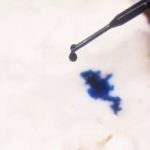
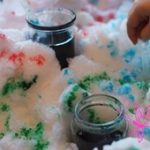
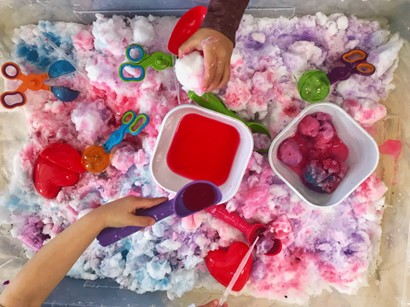
Use your fine motor skills by using molds in the snow!
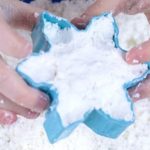
Have fun!